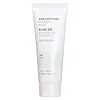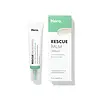The Face Shop Air Cotton Makeup Base SPF 30 PA++ Versus Hero Cosmetics Rescue Balm Color Correcting Green Cream
What's inside
What's inside
 Key Ingredients
Key Ingredients

 Benefits
Benefits

 Concerns
Concerns

 Ingredients Side-by-side
Ingredients Side-by-side

Water
Skin ConditioningCyclopentasiloxane
EmollientCyclohexasiloxane
EmollientTitanium Dioxide
Cosmetic ColorantDipropylene Glycol
HumectantZinc Oxide
Cosmetic ColorantButylene Glycol
HumectantCetyl PEG/PPG-10/1 Dimethicone
EmulsifyingButylene Glycol Dicaprylate/Dicaprate
EmollientNiacinamide
SmoothingSodium Chloride
MaskingPEG-10 Methyl Ether Dimethicone
EmulsifyingMica
Cosmetic ColorantGossypium Herbaceum Extract
Skin ConditioningAnthemis Nobilis Flower Water
MaskingVolcanic Ash
AbrasiveChenopodium Quinoa Seed Extract
Skin ConditioningRosa Damascena Flower Water
MaskingDimethicone
EmollientDisteardimonium Hectorite
StabilisingAluminum Hydroxide
EmollientStearic Acid
CleansingDimethicone/Vinyl Dimethicone Crosspolymer
Skin ConditioningTriethyl Citrate
MaskingHydrogen Dimethicone
Adenosine
Skin ConditioningHydrogenated Lecithin
EmulsifyingDisodium EDTA
Phenoxyethanol
PreservativeCaprylyl Glycol
EmollientEthylhexylglycerin
Skin Conditioning1,2-Hexanediol
Skin ConditioningParfum
MaskingCitric Acid
BufferingSodium Benzoate
MaskingPotassium Sorbate
PreservativeChromium Oxide Greens
Water, Cyclopentasiloxane, Cyclohexasiloxane, Titanium Dioxide, Dipropylene Glycol, Zinc Oxide, Butylene Glycol, Cetyl PEG/PPG-10/1 Dimethicone, Butylene Glycol Dicaprylate/Dicaprate, Niacinamide, Sodium Chloride, PEG-10 Methyl Ether Dimethicone, Mica, Gossypium Herbaceum Extract, Anthemis Nobilis Flower Water, Volcanic Ash, Chenopodium Quinoa Seed Extract, Rosa Damascena Flower Water, Dimethicone, Disteardimonium Hectorite, Aluminum Hydroxide, Stearic Acid, Dimethicone/Vinyl Dimethicone Crosspolymer, Triethyl Citrate, Hydrogen Dimethicone, Adenosine, Hydrogenated Lecithin, Disodium EDTA, Phenoxyethanol, Caprylyl Glycol, Ethylhexylglycerin, 1,2-Hexanediol, Parfum, Citric Acid, Sodium Benzoate, Potassium Sorbate, Chromium Oxide Greens
Water
Skin ConditioningDipropylene Glycol
HumectantIsononyl Isononanoate
EmollientButylene Glycol
HumectantOctyldodecanol
EmollientDiethylhexyl Carbonate
EmollientButyloctyl Salicylate
Skin ConditioningButyrospermum Parkii Butter
Skin ConditioningPolyglyceryl-3 Polyricinoleate
EmulsifyingSilica
AbrasivePanthenol
Skin ConditioningSodium Chloride
MaskingDisteardimonium Hectorite
StabilisingMica
Cosmetic ColorantHydrogenated Poly(C6-14 Olefin)
EmollientHydrogenated Polydecene
EmollientHydrogenated Polyisobutene
EmollientPolyglyceryl-4 Diisostearate/Polyhydroxystearate/Sebacate
EmulsifyingBeta-Glucan
Skin ConditioningTocopheryl Acetate
AntioxidantSpirulina Platensis Powder
Skin ProtectingTheobroma Cacao Fruit Powder
Skin ConditioningRh-Polypeptide-1
Skin ConditioningSh-Oligopeptide-1
Skin ConditioningSh-Oligopeptide-2
Skin ConditioningRh-Polypeptide-62
Skin ConditioningRh-Polypeptide-3
Skin ConditioningAllantoin
Skin ConditioningGlycerin
HumectantSynthetic Beeswax
Emulsion StabilisingPolyglyceryl-2 Triisostearate
EmulsifyingPropylene Carbonate
SolventSorbitan Isostearate
EmulsifyingAcrylates/Ammonium Methacrylate Copolymer
Xanthan Gum
EmulsifyingCaprylyl Glycol
EmollientTriethoxycaprylylsilane
Diglycerin
HumectantAluminum Hydroxide
EmollientBoron Nitride
Absorbent1,2-Hexanediol
Skin ConditioningSodium Benzoate
MaskingPotassium Sorbate
PreservativeEthylhexylglycerin
Skin ConditioningCI 77891
Cosmetic ColorantCI 77491
Cosmetic ColorantCI 77492
Cosmetic ColorantCI 77499
Cosmetic ColorantCI 77288
Cosmetic ColorantWater, Dipropylene Glycol, Isononyl Isononanoate, Butylene Glycol, Octyldodecanol, Diethylhexyl Carbonate, Butyloctyl Salicylate, Butyrospermum Parkii Butter, Polyglyceryl-3 Polyricinoleate, Silica, Panthenol, Sodium Chloride, Disteardimonium Hectorite, Mica, Hydrogenated Poly(C6-14 Olefin), Hydrogenated Polydecene, Hydrogenated Polyisobutene, Polyglyceryl-4 Diisostearate/Polyhydroxystearate/Sebacate, Beta-Glucan, Tocopheryl Acetate, Spirulina Platensis Powder, Theobroma Cacao Fruit Powder, Rh-Polypeptide-1, Sh-Oligopeptide-1, Sh-Oligopeptide-2, Rh-Polypeptide-62, Rh-Polypeptide-3, Allantoin, Glycerin, Synthetic Beeswax, Polyglyceryl-2 Triisostearate, Propylene Carbonate, Sorbitan Isostearate, Acrylates/Ammonium Methacrylate Copolymer, Xanthan Gum, Caprylyl Glycol, Triethoxycaprylylsilane, Diglycerin, Aluminum Hydroxide, Boron Nitride, 1,2-Hexanediol, Sodium Benzoate, Potassium Sorbate, Ethylhexylglycerin, CI 77891, CI 77491, CI 77492, CI 77499, CI 77288
 Reviews
Reviews

Ingredients Explained
These ingredients are found in both products.
Ingredients higher up in an ingredient list are typically present in a larger amount.
1,2-Hexanediol is a synthetic liquid and another multi-functional powerhouse.
It is a:
- Humectant, drawing moisture into the skin
- Emollient, helping to soften skin
- Solvent, dispersing and stabilizing formulas
- Preservative booster, enhancing the antimicrobial activity of other preservatives
Aluminum Hydroxide is a form of aluminum. It can be naturally found in nature as the mineral gibbsite. In cosmetics, Aluminum Hydroxide is used as a colorant, pH adjuster, and absorbent.
As a colorant, Aluminum Hydroxide may add opacity, or reduce the transparency. Aluminum hydroxide is contains both basic and acidic properties.
According to manufacturers, this ingredient is an emollient and humectant. This means it helps hydrate the skin.
In medicine, this ingredient is used to help relieve heartburn and help heal ulcers.
There is currently no credible scientific evidence linking aluminum hydroxide in cosmetics to increased cancer risk.
Major health organizations allow the use of aluminum hydroxide in personal care products and have not flagged it as a carcinogenic risk at typical usage levels.
Learn more about Aluminum HydroxideButylene Glycol (or BG) is used within cosmetic products for a few different reasons:
Overall, Butylene Glycol is a safe and well-rounded ingredient that works well with other ingredients.
Though this ingredient works well with most skin types, some people with sensitive skin may experience a reaction such as allergic rashes, closed comedones, or itchiness.
Learn more about Butylene GlycolCaprylyl Glycol is a humectant and emollient, meaning it attracts and preserves moisture.
It is a common ingredient in many products, especially those designed to hydrate skin. The primary benefits are retaining moisture, skin softening, and promoting a healthy skin barrier.
Though Caprylyl Glycol is an alcohol derived from fatty acids, it is not the kind that can dry out skin.
This ingredient is also used as a preservative to extend the life of products. It has slight antimicrobial properties.
Learn more about Caprylyl GlycolDipropylene Glycol is a synthetically created humectant, stabilizer, and solvent.
This ingredient helps:
Dipropylene glycol is technically an alcohol, but it belongs to the glycol family (often considered part of the ‘good’ alcohols). This means it is hydrating and gentle on skin unlike drying solvent alcohols like denatured alcohol.
As a masking agent, Dipropylene Glycol can be used to cover the smell of other ingredients. However, it does not have a scent.
Studies show Dipropylene Glycol is considered safe to use in skincare.
Learn more about Dipropylene GlycolDisteardimonium Hectorite comes from the clay mineral named hectorite. It is used to add thickness to a product.
It can also help stabilize a product by helping to disperse other ingredients.
Hectorite is a rare, white clay mineral.
Learn more about Disteardimonium HectoriteEthylhexylglycerin (we can't pronounce this either) is commonly used as a preservative and skin softener. It is derived from glyceryl.
You might see Ethylhexylglycerin often paired with other preservatives such as phenoxyethanol. Ethylhexylglycerin has been found to increase the effectiveness of these other preservatives.
Mica is a naturally occurring mineral used to add shimmer and color in cosmetics. It can also help improve the texture of a product or give it an opaque, white/silver color.
Serecite is the name for very fine but ragged grains of mica.
This ingredient is often coated with metal oxides like titanium dioxide. Trace amounts of heavy metals may be found in mica, but these metals are not harmful in our personal products.
Mica has been used since prehistoric times throughout the world. Ancient Egyptian, Indian, Greek, Roman, Aztec, and Chinese civilizations have used mica.
Learn more about MicaPotassium Sorbate is a preservative used to prevent yeast and mold in products. It is commonly found in both cosmetic and food products.
This ingredient comes from potassium salt derived from sorbic acid. Sorbic acid is a natural antibiotic and effective against fungus.
Both potassium sorbate and sorbic acid can be found in baked goods, cheeses, dried meats, dried fruit, ice cream, pickles, wine, yogurt, and more.
You'll often find this ingredient used with other preservatives.
Learn more about Potassium SorbateSodium Benzoate is a preservative. It's used in both cosmetic and food products to inhibit the growth of mold and bacteria. It is typically produced synthetically.
Both the US FDA and EU Health Committee have approved the use of sodium benzoate. In the US, levels of 0.1% (of the total product) are allowed.
Sodium benzoate works as a preservative by inhibiting the growth of bacteria inside of cells. It prevents the cell from fermenting a type of sugar using an enzyme called phosphofructokinase.
It is the salt of benzoic acid. Foods containing sodium benzoate include soda, salad dressings, condiments, fruit juices, wines, and snack foods.
Studies for using ascorbic acid and sodium benzoate in cosmetics are lacking, especially in skincare routines with multiple steps.
We always recommend speaking with a professional, such as a dermatologist, if you have any concerns.
Learn more about Sodium BenzoateChances are, you eat sodium chloride every day. Sodium Chloride is also known as table salt.
This ingredient has many purposes in skincare: thickener, emulsifier, and exfoliator.
You'll most likely find this ingredient in cleansers where it is used to create a gel-like texture. As an emulsifier, it also prevents ingredients from separating.
There is much debate on whether this ingredient is comedogenic. The short answer - comedogenic ratings don't tell the whole story. Learn more about comegodenic ratings here.
The concensus about this ingredient causing acne seems to be divided. Research is needed to understand if this ingredient does cause acne.
Scrubs may use salt as the primary exfoliating ingredient.
Learn more about Sodium ChlorideWater. It's the most common cosmetic ingredient of all. You'll usually see it at the top of ingredient lists, meaning that it makes up the largest part of the product.
So why is it so popular? Water most often acts as a solvent - this means that it helps dissolve other ingredients into the formulation.
You'll also recognize water as that liquid we all need to stay alive. If you see this, drink a glass of water. Stay hydrated!
Learn more about Water